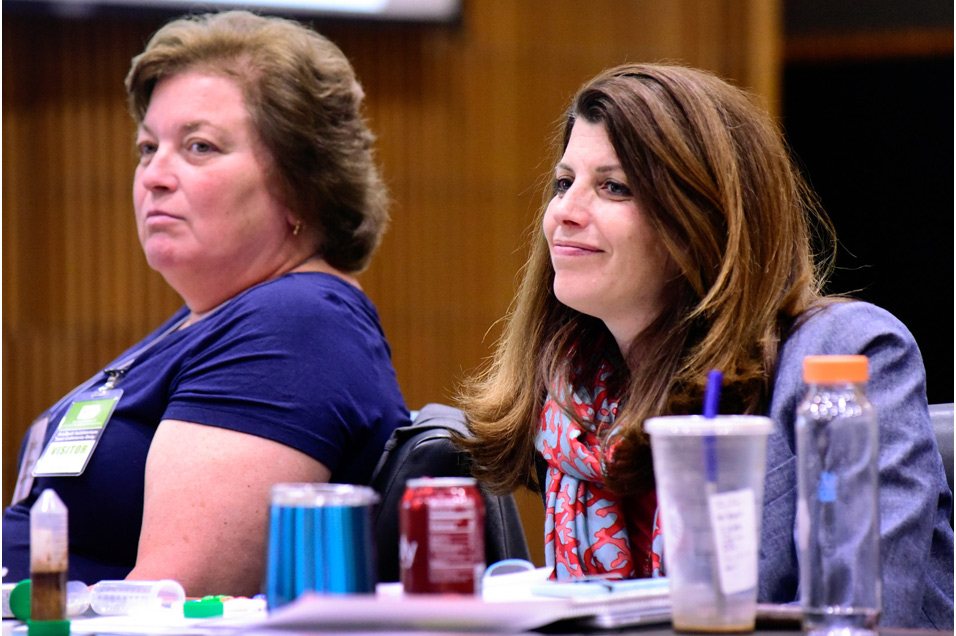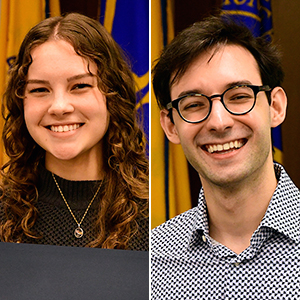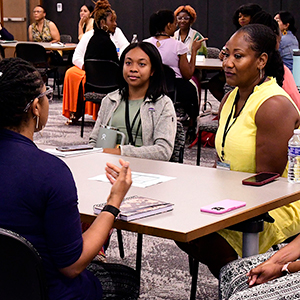In recognition of Earth Day April 22, the NIEHS Environmental Awareness Advisory Committee (EAAC) offered a week of educational events with the theme “Protect Our Species.”
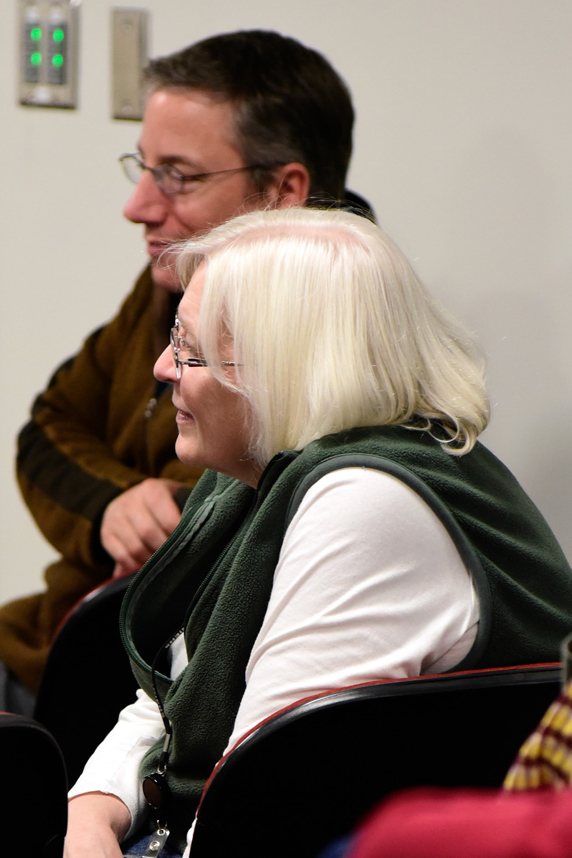 Johnson, rear, and Diane Spencer, from the National Toxicology Program, learned about reintroduction of red wolves in eastern North Carolina. (Photo courtesy of Steve McCaw)
Johnson, rear, and Diane Spencer, from the National Toxicology Program, learned about reintroduction of red wolves in eastern North Carolina. (Photo courtesy of Steve McCaw)Activities included facility tours, several talks, and shared activities with the U.S. Environmental Protection Agency, which shares a campus with NIEHS, and the popular Bring Your Child to Work Day Science Fair.
“We are always excited to have these Earth Day events,” said Paul Johnson, EAAC chair and manager of the NIEHS Environmental Protection and Stewardship Programs. “There is much to learn about sustainable practices we can engage in — as individuals and as an organization.”
The EAAC acts as an advisory body to NIEHS management. “We suggest actions that the institute can take to be more sustainable,” said Laura Hall, a biologist and EAAC committee member who helped plan the “Protect Our Species” events.
Saving Canis rufus
On Earth Day, institute staff attended a presentation about the endangered red wolf, which once roamed parts of 24 states in the Eastern and Southeastern United States. Captive breeding of the red wolf began in 1967, said Kim Wheeler, executive director of the Red Wolf Coalition.
 Captive red wolf in 2013 at Species Survival Plan facility, Point Defiance Zoo and Aquarium, in Tacoma, Washington. (Photo courtesy of B. Bartel, U.S. Fish and Wildlife Service under CC BY 2.0 license)
Captive red wolf in 2013 at Species Survival Plan facility, Point Defiance Zoo and Aquarium, in Tacoma, Washington. (Photo courtesy of B. Bartel, U.S. Fish and Wildlife Service under CC BY 2.0 license)Reintroduction into the wild, in North Carolina’s Alligator River National Wildlife Refuge, began 20 years later. The North Carolina wolves are the only wild population of red wolves in the world.
“When I started in 2005, there were 130 wolves in the refuge,” said Wheeler. “In 2012, we began to see losses due to hunters.” Today, only 25 collared animals remain, said Wheeler, and only two of those are a breeding pair. Another 220 wolves live in 33 zoos and centers across the country.
“Red wolves mate for life, but only once a year,” said Wheeler. “When you kill an animal, they don’t find another mate immediately. It reduces the chances that an animal will reproduce.”
 Wheeler’s map showed the red wolf reintroduction area in North Carolina. “We hope that the U.S. Fish and Wildlife Service will take all the information they’ve learned over the last 30 years and write a new recovery plan,” she said. (Photo courtesy of Steve McCaw)
Wheeler’s map showed the red wolf reintroduction area in North Carolina. “We hope that the U.S. Fish and Wildlife Service will take all the information they’ve learned over the last 30 years and write a new recovery plan,” she said. (Photo courtesy of Steve McCaw)Collaboration for education
On April 24, the NIEHS Office of Science Education and Diversity (OSED) conducted a daylong workshop called, “Rx for Science Literacy: Your Environment, Your Health — The NIEHS Gulf Long-term Follow-up Study (GuLF STUDY).”
OSED collaborated with the National Environmental Education Foundation (NEEF), in partnership with the North Carolina Association for Biomedical Research. The week was also NEEF’s National Environmental Education Week.
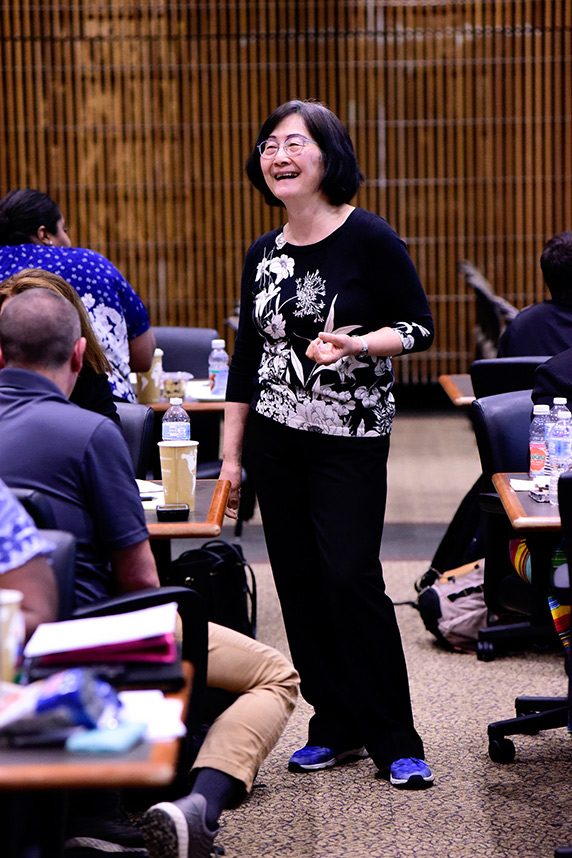 “A good mix of NIEHS and NEEF — in terms of presentation topics and styles,” said Lee, describing the workshop. (Photo courtesy of Steve McCaw)
“A good mix of NIEHS and NEEF — in terms of presentation topics and styles,” said Lee, describing the workshop. (Photo courtesy of Steve McCaw)Teachers who participated in the program were introduced to NEEF online resources and toolkits. NIEHS scientists presented an overview of the GuLF Study of the long-term health effects of the Deepwater Horizon oil spill on 33,000 cleanup workers.
Huei-Chen Lee, Ph.D., the K-12 science education program manager for the OSED, led the workshop, which offered a hands-on simulation of an oil spill cleanup and opportunities for teachers to practice scientific methods. “We do similar workshops twice a year, but this is the first time we have collaborated with NEEF,” said Lee.
NEEF Executive Director Meri-Margaret Deoudes credited OSED head Ericka Reid, Ph.D., with spearheading the collaboration. Reid is an ex officio member of the NEEF board of directors. “We’re trying to focus on the impact of the environment on health, which is also the focus of NIEHS,” said Deoudes.
Bio-based alternatives
On April 25, Sally Shaver and Elvis Graves, consultants representing the United Soybean Board, spoke on “Shrinking Your Environmental Footprint with Soy.”
“Federal law encourages government agencies to purchase bio-based materials,” said Shaver. “But they have to perform at the level you need them to.” There are some 2,500 approved products in the U.S. Department of Agriculture’s BioPreferred Program.
Cleaning products, carpet backing, ink, insulation, lubricants, paints, synthetic turf, recycled asphalt pavement, tires, and many other products contain soy-based ingredients. “The U.S. is the world’s largest producer of soy,” Shaver said.
(John Yewell is a contract writer for the NIEHS Office of Communications and Public Liaison.)







